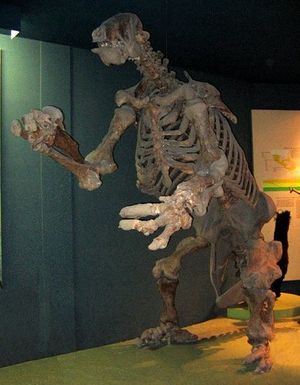الكسلان الأرضي
| الكسلان الأرضي Ground sloths | |
|---|---|

| |
| أحفورات لحيوانات مختلفة من الكسلان الأرضي في المتحف الأمريكي للتاريخ الطبيعي في نيويورك. | |
| التصنيف العلمي | |
| مملكة: | |
| Phylum: | |
| Class: | |
| Subclass: | |
| Infraclass: | |
| Superorder: | |
| Order: | |
| Suborder: | Folivora (partim)
|
| الفصائل | |
| |
الكسلان الأرضي Ground sloths، هي مجموعة متنوعة من حيوانات الكسلان المنقرضة، ضمن ثدييات تحت رتبة غريبات المفاصل. مصطلح "الكسلان الأرضي" استخدم كمرجع لجميع حيوانات الكسلان المنقرضة ذات الحجم الكبير من الأشكال المكتشبة مبكرة، على عكس "كسلان الأشجار" الموجود في العصر الحالي. ومع ذلك، فقد اتفق تاريخياً على أن هذا المصطلح لا يعني أن جميع الكسلان المنقرض كان من الحيوانات الأرضية في الطبيعة.[1] آخر من تبقى منهم كان يعيش في جزر الأنتيل، والذي يعتقد أنه ربما كان يعيش حتى عام 1550 ق.م.[2] ومع ذلك فتأريخ الكربون المشع يشير إلى أنه فيما بين 2819 و2260 ق.م. كان آخر تواجد معروف للكسلان الضخم في كوبا.[3] كان الكسلان الأرضي يعيش في أراضي أمريكا الشمالية والجنوبية من 10.000 سنة أو أكثر.[4] بقت بعض حيوانات الكسلان الأرضي على قيد الحياة في البحر الكاريبي في الفترة المرتبطة بمرحلة ما قبل الاستيطان البشري للمنطقة. ظلت أعداد منه تعيش بشكل منفرد لأكثر من 5.000 إلى 6.000 سنة على عكس أقاربهم على البر القاري، في تطابق مع النمط الرباعي في أواخر العصر الرباعي والذي إتبعته الفقاريات الضخمة بسبب انتشار البشر.[5]
الفصائل
حدد علماء المتحجرات أكثر من 80 جنس من الكسلان الأرضي في فصائل متعددة.[6]
Megalonychidae
Megatheriidae
Nothrotheriidae
Mylodontidae
Orophodontidae
Scelidotheriidae
انقراضه من أمريكا الشمالية
صيد الكسلان الأرضي
أسلحة الصيد
الآثار الاقتصادية
المزايا
الصعوبات
الهوامش
- ^ J.L. White (1993)
- ^ R.M. Nowak (1999)
- ^ MacPhee, R. D. E. (June 2007). "Prehistoric Sloth Extinctions in Cuba: Implications of a New "Last" Appearance Date" (PDF). Caribbean Journal of Science. College of Arts and Sciences, University of Puerto Rico. 43 (1): 94–98. Retrieved 11 May 2009.
{{cite journal}}: Unknown parameter|coauthors=ignored (|author=suggested) (help) - ^ Fiedal, Stuart (2009). "Sudden Deaths: The Chronology of Terminal Pleistocene Megafaunal Extinction". In Haynes, Gary (ed.). American Megafaunal Extinctions at the End of the Pleistocene. Springer. pp. 21–37. doi:10.1007/978-1-4020-8793-6_2. ISBN 978-1-4020-8792-9.
- ^ Steadman, D. W. (2005-08-16). "Asynchronous extinction of late Quaternary sloths on continents and islands" (PDF). Proc. Natl. Acad. Sci. USA. National Academy of Sciences. 102 (33): 11763–11768. doi:10.1073/pnas.0502777102. PMC 1187974. PMID 16085711.
{{cite journal}}: Unknown parameter|coauthors=ignored (|author=suggested) (help) - ^ Modified from McKenna & Bell (1997)
المصادر
- Cuvier, G. (1796): Notice sur le squellette d'une très grande espèce de quadrupède inconnue jusqu'à présent, trouvé au Paraquay, et déposé au cabinet d'histoire naturelle de Madrid. Magasin encyopédique, ou Journal des Sciences, des Lettres et des Arts (1): 303–310; (2): 227–228.
- De Iuliis, G. & Cartelle, C. (1999): A new giant megatheriine ground sloth (Mammalia: Xenarthra: Megatheriidae) from the late Blancan to early Irvingtonian of Florida. Zool. J. Linn. Soc. 127(4): 495–515.
- Harrington, C.R. (1993): Yukon Beringia Interpretive Center – Jefferson's Ground Sloth. Retrieved 2008-JAN-24.
- Hogan, C.M. (2008): Cueva del Milodon, Megalithic Portal. Retrieved 2008-APR-13
- Kurtén, Björn and Anderson, Elaine (1980): Pleistocene Mammals of North America. Columbia University Press, New York. ISBN 0-231-03733-3
- McKenna, Malcolm C. & Bell, Susan K. (1997): Classification of Mammals Above the Species Level. Columbia University Press, New York. ISBN 0-231-11013-8
- Nowak, R.M. (1999): Walker's Mammals of the World (Vol. 2). Johns Hopkins University Press, London.
- White, J.L. (1993): Indicators of locomotor habits in Xenarthrans: Evidence for locomotor heterogeneity among fossil sloths. Journal of Vertebrate Paleontology, 13(2): 230–242.
- White, J.L. & MacPhee, R.D.E. (2001): The sloths of the West Indies: a systematic and phylogenetic review. In: Woods, C.A. & Sergile, F.E. (eds.): Biogeography of the West Indies: Patterns and Perspectives: 201–235.
- Woodward, A.S. (1900): On some remains of Grypotherium (Neomylodon) listai and associated mammals from a cavern near Consuelo Cove, Last Hope Inlet, Patagonia. Proceedings of the Zoological Society of London, 1900(5): 64–79.
وصلات خارجية
- Sloth World: An Online Sloth Bibliography.
- Picture and information about a ground sloth skeleton on display at the University of Georgia's Science Library.
- Academy of Natural Sciences ground sloth page.
- Illinois State Museum ground sloth page.
- Ground sloths at La Brea.
- Eremotherium in Florida.
- Have some ground sloths survived in Argentina?
- Ground sloths in general.
- Western Center for Archaeology and Paleontology Hemet, CA

